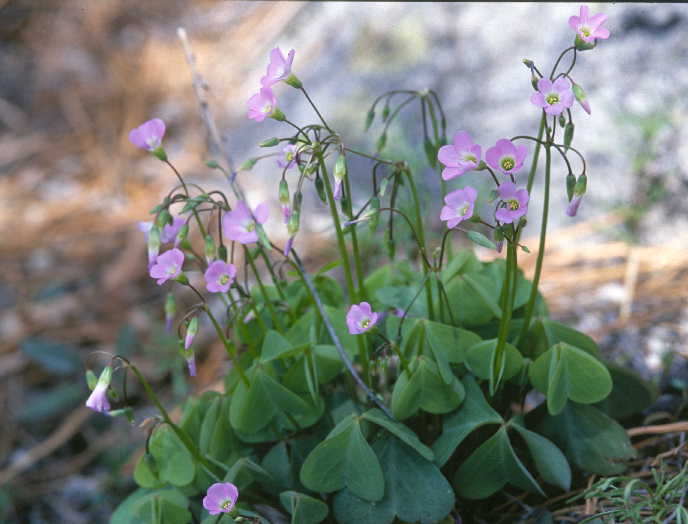|
|
|
|
Family: Oxalidaceae
violet woodsorrel
[Ionoxalis violacea (L.) Small, moreOxalis violacea var. trichophora Fassett, Sassia violacea (L.) Holub] |
Perennial from a scaly bulbous base; lvs glabrous, or the petioles sometimes hairy; peduncles erect, 1-2 dm, much surpassing the lvs, with an umbelliform cluster of pedicellate fls subtended by small bracts; pet commonly rose-violet (white), 10-18 mm, not retuse; sep callous-tipped; 2n=28. Dry upland woods and prairies; Mass. to N.D., s. to Fla. and Tex. Apr.-June. (Ionoxalis v.) Gleason, Henry A. & Cronquist, Arthur J. 1991. Manual of vascular plants of northeastern United States and adjacent Canada. lxxv + 910 pp. ©The New York Botanical Garden. All rights reserved. Used by permission. Martin and Hutchins 1980, Allred and Ivey 2012, Heil et al. 2013 Duration: Perennial Nativity: Native Lifeform: Forb/Herb General: Perennial scapose herb, 10-40 cm tall, from a bulb; stems erect, thin, leafless, scapelike; bulbs covered with 3-nerved scales. Leaves: On long erect stem-like petioles which emerge directly from the base of the plant; blades divided into 3 leaflets, the leaflets glabrous, 10-25 mm wide, obreniform with a shallow notch at the apex, which divides the leaflet tip into two rounded lobes. Flowers: Purple, in few-flowered cymes at the tops of leafless stems, 10-40 cm tall; sepals 5 per flower, 4-6 mm long, each with a pair of tubercules at the tip; petals 5 per flower, 15-20 mm long, violet. Fruits: Capsules ovoid, 4-5 cm long. Ecology: Found on open slopes, from 7,000-9,000 ft (2134-2743 m); flowers June-August. Distribution: ME to FL, west to TX and NM Notes: Oxalis violacea is common in the eastern US, and when looking at a dot map of locations, New Mexico populations are disjunct from the overall distribution. The species is described as widespread in New Mexico by The Flora of New Mexico (Martin and Hutchins, 1980), and the above description follows the treatment from that text. However, more recent floras do not include O. violacea as part of the New Mexico Flora. Flora Neomexicana (Allred and Ivey 2012) notes that many specimens of O. latifolia and O. metcalfei were previously identified as O. violacea. O. metcalfei has 3-nerved scales on the bulbs and occurs at higher elevations in conifer forests. O. latifolia has 5-11 -nerved bulb scales and occurs in moist weedy habitats at low to middle elevations. Ethnobotany: All parts of the plant can be eaten raw or cooked, in moderation. Care must be taken because high doses of oxalic acid are poisonous. Used internally and topically to get rid of hookworms; used to make a salve to treat skin sores; a cold infusion of the leaves taken for vomiting. Etymology: Oxalis comes from the Greek word oxys, sour, referring to the sour flavor of the oxalic acid; violacea alludes to the violet-colored flowers. Synonyms: Ionoxalis violacea Editor: AHazelton 2017 |
|
|
|


